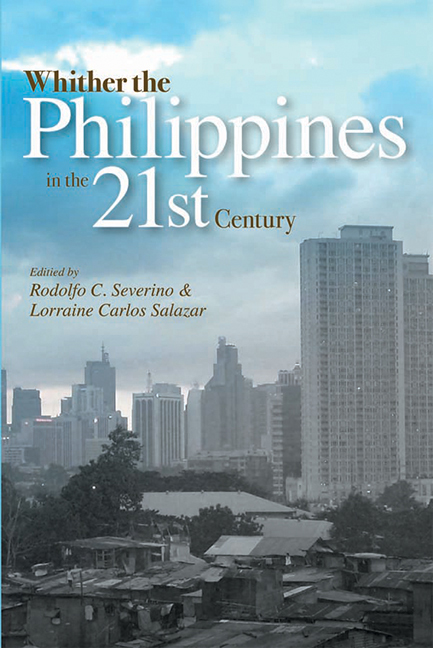Book contents
- Frontmatter
- Contents
- List of Illustrations
- Foreword
- Acknowledgements
- The Contributors
- List of Abbreviations
- Map of Southeast Asia
- 1 The Philippines in Southeast Asia
- 2 From Regime Crisis to System Change
- 3 Proposed Constitutional Reforms for Good Governance and Nation Building
- 4 The Military in Philippine Politics
- 5 Religion and Politics
- 6 The Philippine Press
- 7 Macroeconomic Issues and Challenges
- 8 Investment Climate and Business Opportunities
- 9 Why Does Poverty Persist in the Philippines?
- 10 Diaspora, Remittances, and Poverty
- 11 The Philippine Development Record
- 12 Sancho Panza in Buliok Complex
- 13 The Insurgency That Would Not Go Away
- 14 Whither the Philippines in the 21st Century?
- Index
2 - From Regime Crisis to System Change
Published online by Cambridge University Press: 21 October 2015
- Frontmatter
- Contents
- List of Illustrations
- Foreword
- Acknowledgements
- The Contributors
- List of Abbreviations
- Map of Southeast Asia
- 1 The Philippines in Southeast Asia
- 2 From Regime Crisis to System Change
- 3 Proposed Constitutional Reforms for Good Governance and Nation Building
- 4 The Military in Philippine Politics
- 5 Religion and Politics
- 6 The Philippine Press
- 7 Macroeconomic Issues and Challenges
- 8 Investment Climate and Business Opportunities
- 9 Why Does Poverty Persist in the Philippines?
- 10 Diaspora, Remittances, and Poverty
- 11 The Philippine Development Record
- 12 Sancho Panza in Buliok Complex
- 13 The Insurgency That Would Not Go Away
- 14 Whither the Philippines in the 21st Century?
- Index
Summary
The Philippines is in the midst of a deep, systemic crisis. The crisis confronting the Arroyo regime is not just one more instance of the refusal of competing elite factions to accept the legitimacy of elections as a means for mediating elite competition. The crisis of the Arroyo administration manifests the cumulative impact of a long simmering crisis of representation. It is not just President Arroyo who is being challenged, it is the capacity of the whole political system to select leaders capable of responding to the needs of the Philippines in the twenty-first century.
It is precisely the depth of the crisis that prevents a quick and easy resolution. A functioning state resolves conflict through mechanisms that organizes winners and losers. The deeper the crisis the more difficult it is to identify winners and losers. Political players are being forced to think beyond “who gets what, when and how” and to project from the “here and now” to the future, a difficult and uneasy task for most politicians. Put more simply, politicians cannot be sure how changes in the political system will affect them. As a result, even “system change” gets processed in narrow, partisan ways, distorting discourse, and making negotiated outcomes difficult.
Many political leaders, pro-administration and opposition alike, rhetorically acknowledge the depth of the crisis, but continue to behave in the same old ways. The most obvious is President Gloria Macapagal Arroyo. For years she has talked about the crisis in the political system and the need to reform the institutions of government. In September 2005, for example, she said that charter change is one major step the nation must take to achieve peace and stability over the “rapidly degenerating political system”. But she has also behaved like an old-style traditional politician, a trapo. Worst, since the onset of the crisis only a little more than a year ago, she has undermined the very political institutions she would reform.
- Type
- Chapter
- Information
- Whither the Philippines in the 21st Century? , pp. 18 - 42Publisher: ISEAS–Yusof Ishak InstitutePrint publication year: 2007

